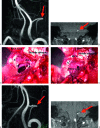Transcondylar fossa (supracondylar transjugular tubercle) approach: anatomic basis for the approach, surgical procedures, and surgical experience
- PMID: 20808532
- PMCID: PMC2853075
- DOI: 10.1055/s-0029-1242193
Transcondylar fossa (supracondylar transjugular tubercle) approach: anatomic basis for the approach, surgical procedures, and surgical experience
Abstract
The authors clarify the anatomic basis and the usefulness of the transcondylar fossa approach (T-C-F A), in which the posterior portion of the jugular tubercle is removed extradurally through the condylar fossa with the atlanto-occipital joint intact. The authors first performed an anatomic study to identify the area to be removed using cadaveric specimens and then applied the T-C-F A to foramen magnum surgeries. The surgeries included clipping a vertebral artery-posterior inferior cerebellar artery aneurysm in 11 cases, microvascular decompression for glossopharyngeal neuralgia in 15 cases, and removing intradural foramen magnum tumors in 17 cases. Only the condylar fossa was removed, but the approach offered very good visualization of the lateral part of the foramen magnum and sufficient working space. These surgeries were performed safely without major complications. This skull base approach is minimally invasive and is not difficult. Therefore, it can be a standard approach for accessing intradural lesions of the foramen magnum. It can be combined with the transcerebellomedullary fissure approach from the lateral side and can also be easily changed to the transcondylar approach, if necessary.
Keywords: Foramen magnum; VA-PICA aneurysm; foramen magnum tumor; glossopharyngeal neuralgia; lateral approaches.
Figures





Similar articles
-
Microsurgical anatomy for lateral approaches to the foramen magnum with special reference to transcondylar fossa (supracondylar transjugular tubercle) approach.Skull Base Surg. 1998;8(3):119-25. doi: 10.1055/s-2008-1058570. Skull Base Surg. 1998. PMID: 17171046 Free PMC article.
-
Supracondylar transjugular tubercle approach to intradural lesions anterior or anterolateral to the craniocervical junction without resection of the occipital condyle.Turk Neurosurg. 2013;23(2):202-7. doi: 10.5137/1019-5149.JTN.6744-12.1. Turk Neurosurg. 2013. PMID: 23546906
-
Surgery on a saccular vertebral artery-posterior inferior cerebellar artery aneurysm via the transcondylar fossa (supracondylar transjugular tubercle) approach or the transcondylar approach: surgical results and indications for using two different lateral skull base approaches.J Neurosurg. 2001 Aug;95(2):268-74. doi: 10.3171/jns.2001.95.2.0268. J Neurosurg. 2001. PMID: 11780897
-
Surgical approaches: postoperative care and complications "posterolateral-far lateral transcondylar approach to the ventral foramen magnum and upper cervical spinal canal".Childs Nerv Syst. 2008 Oct;24(10):1203-7. doi: 10.1007/s00381-008-0597-5. Epub 2008 Mar 26. Childs Nerv Syst. 2008. PMID: 18365213 Review.
-
Motion-related vascular abnormalities at the craniocervical junction: illustrative case series and literature review.Neurosurg Focus. 2015 Apr;38(4):E6. doi: 10.3171/2015.1.FOCUS14826. Neurosurg Focus. 2015. PMID: 25828500 Review.
Cited by
-
Quantitative Anatomical Study of Tailored Far-Lateral Approach for the VA-PICA Regions.J Neurol Surg B Skull Base. 2015 Feb;76(1):57-65. doi: 10.1055/s-0034-1389373. Epub 2014 Sep 21. J Neurol Surg B Skull Base. 2015. PMID: 25685651 Free PMC article.
-
Surgery of the lateral skull base: a 50-year endeavour.Acta Otorhinolaryngol Ital. 2019 Jun;39(SUPPL. 1):S1-S146. doi: 10.14639/0392-100X-suppl.1-39-2019. Acta Otorhinolaryngol Ital. 2019. PMID: 31130732 Free PMC article. Review.
-
Course of the V3 segment of the vertebral artery relative to the suboccipital triangle as an anatomical marker for a safe far lateral approach: A retrospective clinical study.Surg Neurol Int. 2022 Jul 15;13:304. doi: 10.25259/SNI_346_2022. eCollection 2022. Surg Neurol Int. 2022. PMID: 35928311 Free PMC article.
-
Midline suboccipital approach to a vertebral artery-posterior inferior cerebellar artery aneurysm from the rostral end of the patient using ORBEYE.Surg Neurol Int. 2022 Mar 11;13:87. doi: 10.25259/SNI_1272_2021. eCollection 2022. Surg Neurol Int. 2022. PMID: 35399900 Free PMC article.
-
Multimodal management of giant solid hemangioblastomas in two patients with preoperative embolization.Surg Neurol Int. 2024 Apr 26;15:144. doi: 10.25259/SNI_28_2024. eCollection 2024. Surg Neurol Int. 2024. PMID: 38742001 Free PMC article.
References
-
- Bertalanffy H, Seeger W. The dorsolateral, suboccipital, transcondylar approach to the lower clivus and anterior portion of the craniocervical junction. Neurosurgery. 1991;29:815–821. - PubMed
-
- Gilsbach J M, Sure U, Mann W. The supracondylar approach to the jugular tubercle and hypoglossal canal. Surg Neurol. 1998;50:563–570. - PubMed
-
- Hakuba A. In: Sekhar LN, Janecka IP, editor. Surgery of Cranial Base Tumors. New York: Raven Press; 1993. Tsujimoto: Transcondyle approach for foramen magnum meningiomas. pp. 671–678.
-
- Heros R C. Lateral suboccipital approach for vertebral and vertebrobasilar artery lesions. J Neurosurg. 1986;64:559–562. - PubMed
-
- Margalit N S, Lesser J B, Singer M, Sen C. Lateral approach to anterolateral tumors at the foramen magnam: factors determining surgical procedure. Neurosurgery. 2005;56(2 Suppl):324–336. - PubMed

